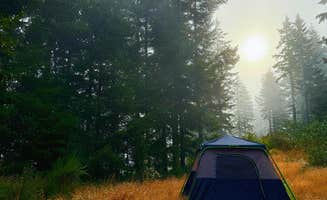Primitive camping near Monroe, Oregon spans across Bureau of Land Management and Siuslaw National Forest lands at elevations ranging from 500 to 2,500 feet. These undeveloped sites experience significant seasonal temperature variations with summer highs reaching 85°F and winter temperatures often dropping below freezing. Most dispersed camping locations require high-clearance vehicles due to narrow forest roads that become impassable during wet conditions.
What to do
Fishing at Quartzville Recreation Corridor: Follow Quartzville Road past mile marker 17.2 for multiple riverside camping spots spanning 12 miles. "It is great for fly fishing and for plunk and wait fishing," notes one camper at Quartzville Recreation Corridor.
Wildlife watching at Beaver Creek: Located within 30 minutes of Monroe, this area offers beaver sightings along the creek. "I did see about 5 beavers close to the road though, so that was sweet," reports a camper at Forest Road 51 near Beaver Creek.
Paddling on Hult Pond: Non-motorized boats only on this former log pond. "The pond was great for kayaking and there is plenty to explore if you aren't worried about a little elevation in your hike," shares a visitor at Hult Pond.
Mushroom hunting: Fall visitors can forage for edible mushrooms in the dense forests. "My friends have found chanterelles in the woods," mentions a regular Quartzville visitor.
What campers like
Stargazing in old growth forests: The dense tree cover creates exceptional darkness. "It was dark, and I mean truly dark in there when you shut off your lights off, and silent as a tomb. Huge uncut trees, bad ass country!" reports a camper at Suislaw National Forest Dispersed Camping.
Sunset views from elevated sites: Several forest road pullouts offer panoramic views. "Unbelievable vista off paved and then maintained gravel road... It was awesome to car camp here," describes a visitor at Forest Road 55 Pulloff.
Spring camping with fewer crowds: Early season visitors often have sites to themselves. "I went during my spring break and I was lucky that it was too cold for most people to camp there. It was beautiful and quiet (other than the 9pm daily goose choir)," notes a Hult Pond camper.
Digital disconnection: Most sites have no cell service. "About an 1 hour from Corvallis but worth it if you can go at a good time! No service but great from a seclusion! So remember all games and firewood you need!!" advises a camper at Near Fawn Creek.
What you should know
Fire restrictions and bans: Summer camping often prohibits fires completely. "Always follow the guide for the area about campfires. Such as August most times there are NO Camp Fires! Be prepare for fire danger, have axe, shovel and 5-gal of water," warns a Quartzville visitor.
Road navigation challenges: Many access roads require careful driving. "When you get to the top of the road it Ts with another forest road, where there was a pull off that would fit one or two cars/vans. Turn left and there are three more sites, two are a few minutes down this other road," explains a visitor at BLM Kentucky Falls Road.
Site availability timing: Prime spots fill quickly, especially on weekends. "Only a few good spots and they go fast so definitely get there early to get a good spot," advises a Hult Pond visitor.
Pack-in, pack-out requirements: Most sites lack facilities. "They have a bathroom which is a plus but no trash cans so please whatever you pack in make sure to pack it out," notes a Hult Pond camper.
Tips for camping with families
Prepare entertainment without technology: The lack of connectivity requires offline activities. "No service but great from a seclusion! So remember all games and firewood you need!!" reminds a camper from Near Fawn Creek Campground.
Choose sites with toilet access: Few dispersed sites offer facilities. "They have a bathroom which is a plus but no trash cans so please whatever you pack in make sure to pack it out," points out a Hult Pond visitor.
Plan for wildlife encounters: Animal sightings are common. "The pond was great for kayaking and there is plenty to explore if you aren't worried about a little elevation in your hike," shares a Hult Pond camper who enjoyed wildlife viewing.
Expect weather variability: Temperature swings can be significant even in summer. "I only saw two others- one camper van going further in the forest where there were several other spots. I would definitely come back given the location and ease of access," notes a Forest Road 55 visitor.
Tips from RVers
Size restrictions for larger vehicles: Narrow roads limit access for big rigs. "Narrow and unpaved road. Very narrow, My trailer could barely fit through and there was only a three-way intersection inside to make a U-turn, otherwise my trailer wouldn't be able to get out!" warns an RV owner who attempted Near Fawn Creek Campground (BLM).
Turnaround challenges: Plan your route with limited turnaround options. "We have a 38 foot rv. We got stuck in a ditch. Rv almost tipped over trying to u turn… if you go down the main lower path you will find a area big enough to u turn! Dont do it until then!" cautions a Hult Pond visitor.
Tree cover impacts solar power: Dense forests limit solar charging options. "I found a pretty pulloff area, but quickly realized it's no good if you rely on cell service, solar and/or starlink due to the tree coverage," notes a Hult Pond visitor.
Check road conditions before committing: Access deteriorates in wet weather. "Need AWD or 4x4. Excellent spot up 2 steep inclines. Some of the most beautiful views. Good fire ring. Do not attempt if wet," advises a Suislaw National Forest camper.




